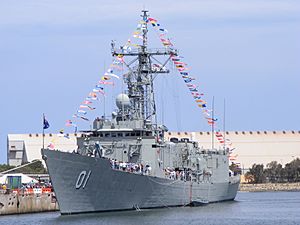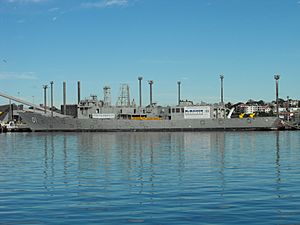HMAS Adelaide (FFG 01) facts for kids

HMAS Adelaide docked at Port Adelaide for an open day in 2007
|
|
Quick facts for kids History |
|
|---|---|
| Namesake | City of Adelaide |
| Builder | Todd Pacific Shipyards, Seattle |
| Laid down | 29 July 1977 |
| Launched | 21 June 1978 |
| Commissioned | 15 November 1980 |
| Decommissioned | 19 January 2008 |
| Motto | "United For The Common Good" |
| Nickname(s) | FFG-17 (US hull designation during construction) |
| Honours and awards |
|
| Fate | Sunk as dive wreck |
| General characteristics | |
| Class and type | Adelaide-class guided missile frigate |
| Displacement | 4,100 tons |
| Length | 138.1 m (453.1 ft) overall |
| Beam | 13.7 m (44.9 ft) |
| Draught | 7.5 m (24.6 ft) |
| Propulsion |
|
| Speed | 29 knots (54 km/h; 33 mph) |
| Range | 4,500 nmi (8,334 km; 5,179 mi) at 20 knots (37 km/h; 23 mph) |
| Complement | 184 (including 15 officers, not including aircrew) |
| Sensors and processing systems |
|
| Armament |
|
| Aircraft carried | 2 × S-70B Seahawk or 1 × Seahawk and 1 × AS350B Squirrel |
HMAS Adelaide (FFG 01) was the first ship of the Adelaide class class. These were guided missile frigates built for the Royal Australian Navy (RAN). Her design was based on the United States Navy's Oliver Hazard Perry-class frigate class. Adelaide was built in the United States and joined the RAN in 1980.
During her time in service, Adelaide took part in many important events. These included helping during the 1987 Fijian coups d'état, the Iraq invasion of Kuwait, and the Indonesian riots of May 1998. She also joined the INTERFET peacekeeping group, and helped in the War in Afghanistan and the United States-led invasion of Iraq. In 1997, the frigate rescued two sailors from a solo yacht race around the world. In 2001, Adelaide stopped a boat carrying suspected illegal immigrants. This event became known as the Children overboard affair.
In 2008, Adelaide was the second ship of her class to be taken out of service. This was done to help pay for upgrades to the other four ships. She was later sunk off Avoca Beach, New South Wales. This created a dive wreck for people to explore. After some delays and clean-up work, Adelaide was finally sunk on 13 April 2011.
Building a Warship: HMAS Adelaide's Design
The HMAS Adelaide was a type of warship called a guided missile frigate. It was designed to carry missiles and other weapons.
Choosing the Right Design
After Australia cancelled a plan for new destroyers in 1973, they looked for other options. They considered British and American ship designs. The American Oliver Hazard Perry class was chosen. This was because it could carry the right missiles and past experiences with American designs were good. In 1976, Australia decided to buy two of these ships, including Adelaide. More ships were ordered later, with some built in the US and some in Australia.
Ship's Size and Power
When first built, Adelaide weighed about 3,605 tons. It was 135.6 metres (444.9 ft) long and 13.7 metres (44.9 ft) wide. Later, the ship was updated. This made it slightly longer, at 138.1 metres (453.1 ft), and heavier, at 4,100 tons.
The ship was powered by two large gas turbines. These engines gave it a lot of power, allowing it to reach a top speed of 29 knots (54 km/h; 33 mph) (about 54 km/h). It could travel 4,500 nautical miles (8,334 km; 5,179 mi) (about 8,300 km) without needing to refuel. For moving slowly in tight spaces, it also had two smaller electric motors. The ship usually had a crew of 184 people.
Weapons and Sensors
Adelaide carried a variety of weapons:
- A Mark 13 missile launcher for firing RIM-66 Standard (for air defence) and RGM-84 Harpoon (for attacking other ships) missiles.
- A 76-millimetre (3 in) gun for general use.
- A Vulcan Phalanx system for shooting down incoming missiles or aircraft very close to the ship.
- Two Mark 32 torpedo tubes for firing torpedoes at submarines.
- Up to six 12.7-millimetre (0.50 in) machine guns for close-range defence.
- Sometimes, two .50 calibre machine guns in special mounts were added for deployments.
The ship also had advanced sensors:
- AN/SPS-49 radar to find aircraft in the sky.
- AN/SPS-55 radar for finding ships on the surface and for navigation.
- SPG-60 radar to help aim its missiles and guns.
- AN/SQS-56 sonar to detect objects underwater, like submarines.
Adelaide could also carry two helicopters. These were usually S-70B Seahawks, or one Seahawk and one AS350B Squirrel.
Building and Launching
Adelaide was built at Todd Pacific Shipyards in Seattle, USA. Work began on 29 July 1977. She was launched into the water on 21 June 1978. Lady Ann Synnot, the wife of a top naval officer, officially launched the ship. Adelaide officially joined the Royal Australian Navy on 15 November 1980. During its construction, the US Navy called it FFG-17.
HMAS Adelaide's Missions and Adventures
After joining the Navy, Adelaide stayed in the United States for training. In early 1981, she briefly ran aground near Seattle but only had minor damage.
Early Years and Training
In 1984, Adelaide helped the Navy learn how to fly helicopters from smaller ships. This was important after Australia's aircraft carrier was taken out of service. Adelaide was recognized as the most efficient ship in the RAN that year, winning the Duke of Gloucester Cup.
Helping in Fiji (1987)
In May 1987, Adelaide was visiting Fiji when a military takeover happened. Adelaide and her sister ship Sydney were told to stay near Fiji. Their job was to help evacuate any Australian citizens if needed. This mission was called Operation Morris Dance. Adelaide stayed on duty for several weeks.
Gulf War and New Home (1990s)
In July 1990, Adelaide made history by being the first Australian warship to visit Tahiti since 1970. A month later, in August, Adelaide was sent to the Middle East. She joined Darwin and Success for Operation Damask. This was Australia's part in stopping Iraq after its invasion of Kuwait. Adelaide helped with surveillance and inspecting ships. In 1992, Adelaide moved its home port to HMAS Stirling in Western Australia. This was part of a plan to have naval bases on both sides of Australia.
Rescue at Sea (1997)
In January 1997, two yachts capsized in the Southern Ocean during a solo race around the world. Adelaide searched for seven days and successfully found and rescued the two sailors. Later that year, she represented Australia at a naval review in the Philippines.
Helping in Indonesia and East Timor (1998-1999)
In May 1998, Adelaide was on standby during riots in Indonesia. She was ready to help evacuate Australians if needed, but her help was not required. In February 1999, Adelaide again won the Duke of Gloucester Cup for being the most efficient ship. From September to October 1999, the frigate was sent to East Timor. She was part of the Australian-led INTERFET peacekeeping group.
The Children Overboard Incident (2001)
On 6 October 2001, Adelaide stopped a boat carrying over 200 passengers, including children. This event became known as the Children overboard affair. Adelaide tried to stop the boat from entering Australian waters. When the boat did not stop, Adelaide fired warning shots and sent a boarding party. Some passengers tried to damage their boat or jumped into the water. Adelaides crew rescued those who went overboard. The boat later sank, and Adelaides crew rescued everyone on board. Reports about this event were later found to be misleading.
Middle East Deployments (2001-2005)
From November 2001 to March 2002, Adelaide was sent to the Middle East for Operation Slipper. This was Australia's contribution to the War in Afghanistan. She also helped enforce sanctions against Iraq. Adelaide returned to the Middle East from July 2004 to January 2005 for Operation Catalyst. This mission supported the rebuilding of Iraq after the 2003 invasion.
During this deployment in December 2004, a group of Iranian gunboats tried to capture an Australian boarding party. The Australians had just inspected a freighter that had run aground. The Australian sailors defended themselves and warned the Iranians to back off. After a four-hour standoff, Adelaide's helicopter evacuated the Australians. No shots were fired. This incident was not reported to the public until 2007.
In March 2010, Adelaide was given special honours for her service in East Timor (1999) and the Persian Gulf (2001–02).
HMAS Adelaide's Final Journey
Adelaide was originally planned to be taken out of service in November 2006. However, delays in upgrading her sister ships meant she stayed in service for another 14 months.
Decommissioning and Preparation for Sinking
Adelaide was officially taken out of service on 19 January 2008 at HMAS Stirling. She was then towed to Sydney and given to the New South Wales Government. The plan was to sink her as a dive wreck off the coast near Terrigal. This would be the first military ship dive wreck in New South Wales.
Preparations for sinking took place in late 2009 and early 2010. Her mast was removed, and dangerous materials were taken out. Holes were cut in the ship's sides to help it sink. The sinking was planned for 27 March, about 1.7 kilometres (1.1 mi) off Avoca Beach, New South Wales.
Delays and Final Sinking
Local groups tried to stop the sinking. They worried about how the wreck might affect ocean currents and sand. They also claimed that not all harmful chemicals had been removed from the ship. An appeal to a special tribunal put the project on hold. This led to more clean-up work and increased the cost of the project to $8.5 million.
A new sinking date was set for 13 April 2011. Adelaide was towed from Sydney Harbour on 11 April. The protest groups made last-minute attempts to stop the sinking. They asked for investigations and even tried to summon whales to the site. Despite these efforts, the sinking went ahead just before midday on 13 April. It was delayed for over an hour by a group of dolphins in the area. Once the charges were fired, Adelaide sank in just two minutes.
See also
 In Spanish: HMAS Adelaide (FFG 01) para niños
In Spanish: HMAS Adelaide (FFG 01) para niños





